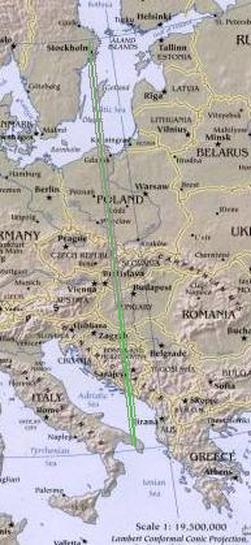
The story takes us from the north in the Swedish capital of Stockholm to the Southern Italian-Roman port of Brindisi (Brundisium). The peculiarity of this locus, which by angular measure of geographic coordinate remains at constant eastward displacement from London, is that it passes from places associated very much with Western civilization to areas surrounded by the mysteries of Eastern European history.
- We are in Stockholm - the center of power of Protestant Scandinavia which exerted its influence on Europe so greatly in 17-th century. To the east we have St. Petersburg, to the west Oslo and Kopenhagen.
- On the southern shore of the Baltic Sea we enter Poland in the Danzig-Gdańsk region, or East Pomerania. The German Prussia originated east of here with the capital in Kœnisgberg. This region, inhabited for centuries by both Poles and Germans, extends south to the town of Bydgoszcz located in the sharp turn of the lower Vistula. South of here we enter the area associated with the origins of Poland as a nation in 10th century.
- Moving further to the south of Poland we pass the boundary between Upper and Lower Silesia at Opole on the river Oder. Silesia is a region where Poles and Germans lived under various political arrangements. The ancient Polish capital of Cracow is east of Silesia.
- We leave Poland and cross into Moravia and lower Slovakia with the capital in Bratislava, reaching the waters of the River Danube, flowing from the German heartlands eastward to the Black Sea. The path of the 18-th meridian leads halfway between Vienna and Budapest - the power center of the sub-Carpathian Central Europe. From there the Slavs were dominated by Germanic influence and led into opposing the Ottoman Turks from the east and south. Poland and Austria were allies against the Turks when the latter presented danger, with the Poles bringing a crucial victory at Vienna in 1683. A century later Austria took part in partitions of Poland partnering with Russia and Prussia.
- In southwest Hungary we reach Pécs, one of the oldest outposts of Roman Christianity in Eastern Europe and one of the oldest universities in Europe. Crossing the Drava River we go into Croatia.
- Traveling through the short span of Croat land to the banks of the Sava River we cross at Slavonski Brod into Bosnia.
- Our southward passage takes us through the middle of the country of Bosnia which enjoyed religious and political diversity and tolerance for most of its history despite being the westernmost point of the Ottoman empire in Europe during its ascendancy and decline. In recent times Bosnia suffered enormously in conflagrations caused by communist, fascist and nationalist ideologies. We pass near the Bosnian capital of Sarajevo and go on to the ancient port of Dubrovnik. Dubrovnik used to be a republic competing with Venice in trade and political influence.
- Now we sail across the Adriatic to Brindisi - in Roman times the port of Brundisium and an ancient center of commerce with Eastern Mediterranean.
Thus the straight southward line between Stockholm and Brindisi, two points firmly planted in the familiar Western civilization, takes us through areas steeped in an aura of mystery. The mystery is created by the Anglo-American perspective, now projected with great force on the whole world, in which Europe begins in England and ends somewhere along the Berlin-Vienna-Rome line - the line of Iron Curtain.